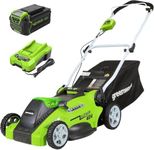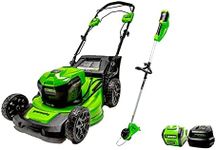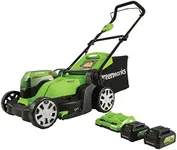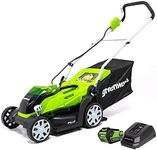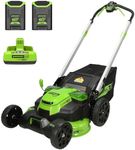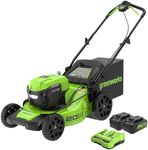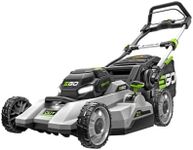Buying Guide for the Best Cordless Lawn Mowers
Choosing a cordless lawn mower can make your lawn care routine much easier and more convenient, especially if you want to avoid the hassle of cords or the maintenance of gas engines. The right mower for you will depend on the size of your lawn, the type of grass you have, and your preferences for features like cutting height and battery life. Understanding the key specifications will help you find a mower that fits your needs and makes mowing your lawn a more enjoyable task.Battery Voltage and CapacityBattery voltage and capacity determine how powerful the mower is and how long it can run on a single charge. Higher voltage usually means more cutting power, which is helpful for thicker or taller grass. Battery capacity, often measured in amp-hours (Ah), tells you how long the mower can operate before needing a recharge. For small lawns, a lower voltage and capacity may be sufficient, while larger or tougher lawns benefit from higher values. Consider your lawn size and how often you want to recharge when choosing the right battery.
Cutting WidthCutting width refers to how wide a strip of grass the mower can cut in one pass. Wider cutting widths allow you to mow your lawn faster, as you cover more ground with each pass. However, a wider mower can be harder to maneuver in tight spaces or around obstacles. For small or intricate lawns, a narrower cutting width may be easier to handle, while larger, open lawns benefit from a wider deck.
Cutting Height AdjustmentCutting height adjustment lets you choose how short or tall you want your grass to be after mowing. This is important because different grass types and seasons may require different cutting heights for healthy growth. Most mowers offer a range of height settings, which can be adjusted with a lever or knob. If you like to change your lawn's appearance or need to adapt to changing conditions, look for a mower with easy and flexible height adjustments.
Run Time and Charging TimeRun time is how long the mower can operate on a full battery, while charging time is how long it takes to recharge the battery. If you have a larger lawn, you'll want a mower with a longer run time or the option to swap batteries. Shorter charging times mean less waiting between mowing sessions. Think about how long it typically takes you to mow your lawn and choose a mower that can handle the job in one go, or consider getting a spare battery for uninterrupted mowing.
Grass Disposal OptionsCordless lawn mowers can handle grass clippings in different ways: bagging, mulching, or side discharge. Bagging collects clippings for easy disposal, mulching chops them finely and returns them to the lawn as natural fertilizer, and side discharge ejects them to the side. Your choice depends on how you want to manage clippings and the look you prefer for your lawn. If you want a tidy lawn with no clippings left behind, bagging is best. If you want to nourish your lawn naturally, mulching is a good option.
Weight and ManeuverabilityThe weight of the mower affects how easy it is to push and turn, especially on uneven ground or around obstacles. Lighter mowers are easier to maneuver, making them a good choice for smaller lawns or users who prefer less physical effort. Heavier mowers may offer more stability on slopes but can be harder to handle. Consider your lawn's layout and your own comfort when choosing the right weight and maneuverability.
Noise LevelCordless lawn mowers are generally quieter than gas models, but noise levels can still vary. If you live in a neighborhood with noise restrictions or prefer a quieter mowing experience, look for models that are specifically designed to operate quietly. This can make mowing more pleasant for you and your neighbors.


